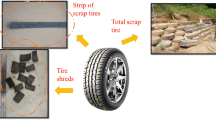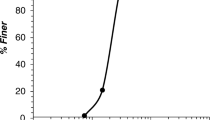Abstract
Stockpiled waste tires are flammable, prone to fires that generate toxic fumes, and may then cause a major health hazard for both human beings and animals. Regarding this matter, this study investigated the beneficial application of worn tires in the form of tire-grid as a layer of reinforcement in a sandy slope. Therefore, large-scale repeated plate load tests were carried out to study the reinforcement effect of the proposed tire-grid under various conditions such as different burial depths and different loading plate diameters. Moreover, one test with a layer of commercial geogrid was performed to compare the efficiency of the tire-grid and geogrid. The results showed that the tire-grid had a significant contribution to improvement of the performance of the sandy slope, bringing about a twofold increase in the bearing capacity in comparison with the unreinforced condition. The optimal condition was reached when the tire-grid was embedded at a burial depth of 0.3B, but the bearing capacity of the plate had an upward trend as the length of the tire-grid increased. It was realized that the proposed tire-grid satisfied all aspects of a sustainable product in terms of the technical, environmental and economical perspectives, confirming that it can be an excellent reinforcing alternative.












Similar content being viewed by others
Availability of Data and Material
This study contains all the required data and materials. Any other materials requested would be available if requested by the journal.
References
European Tyre and Rubber Manufacturers’ Association (2008) Which tyres are to be recovered? http://www.etrma.org
Moghaddas Tafreshi SN, Tavakoli Mehrjardi Gh, Dawson AR (2012) Buried pipes in rubber-soil backfilled trenches under cyclic loading. ASCE J Geotech Geoenviron Eng 138(11):1346–1356
The European Tyre and Rubber Manufacturers’ Association (2019) End of life tyres management—Europe 2019 status
Yoon YW, Heo SB, Kim KS (2008) Geotechnical performance of waste tires for soil reinforcement from chamber tests. Geotext Geomembr 26:100–107
Vinod KG, O’Shaughnessy V (2000) Tire-reinforced earthfill. Part 1: construction of a test fill, performance, and retaining wall design. Can Geotech J. https://doi.org/10.1139/t99-084
Nguyen TH (1996) Utilization of used tyres in civil engineering—the pneusol ‘Tyresoil’. In: Proceedings of the second international congress on environmental geotechnics, Rotterdam, pp 809–814
Ecoflex (2006) Scour protection mat & head and wing wall. Shoalhaven, NSW. /http://www.ecoflex.com.au/erosiongalleryS.
Navaratnarajah SK, Indraratna B (2016) Use of rubber mats to improve the deformation and degradation behavior of rail ballast under cyclic loading. J Geotech Geoenviron Eng 143(6):04017015
Paramasivam B, Dashti S, Liel AB (2020) In-ground gravel-rubber panel walls to mitigate and base isolate shallow-founded structures on liquefiable ground. J Geotech Geoenviron Eng. https://doi.org/10.1061/(ASCE)GT.1943-5606.0002310
Mahgoub A, El Naggar H (2020) Coupled TDA—geocell stress-bridging system for buried corrugated metal pipes. J Geotech Geoenviron Eng. https://doi.org/10.1061/(ASCE)GT.1943-5606.0002279
Kim KS, Yoon YW, Yoon GL (2011) Pullout behavior of cell-type tires in reinforced soil structures. KSCE J Civ Eng 15:1209–1217
Indraratna B, Sun Q, Grant J (2017) Behaviour of subballast reinforced with used tyre and potential application in rail tracks. Transportation Geotechnics 12:26–36
Li LH, Chen YJ, Ferreira PMV, Liu Y, **ao HL (2017) Experimental investigations on the pull-out behavior of tire strips reinforced sands. Materials 10(7):1–13. https://doi.org/10.3390/ma10070707
Li L, Yang J, **ao H, Zhang L (2020) Behavior of tire-geogrid–reinforced retaining wall system under dynamic vehicle load. Int J Geomech 20(4):1–12
Ferreira FB, Topa Gomes A, Vieira CS, Lopes ML (2016) Reliability analysis of geosynthetic-reinforced steep slopes. J Geosynth Int 23(4):301–315
Tavakoli Mehrjardi Gh, Ghanbari A, Mehdizadeh H (2016) Experimental study on the behavior of geogrid-reinforced slopes with respect to aggregate size. Geotext Geomembr 44(6):862–871
Zhijie W, Jacobs F, Ziegler M (2016) Experimental and DEM investigation of geogrid–soil interaction under pullout loads. Geotext Geomembr. https://doi.org/10.1016/j.geotexmem.2015.11.001
Moghaddas Tafreshi SN, Sharifi P, Dawson AR (2016) Performance of circular footings on sand by use of multiple-geocell or -planar geotextile reinforcing layers. Soils Found. https://doi.org/10.1016/j.sandf.2016.11.004
Suku L, Prabhu SS, Babu GLS (2017) Effect of geogrid-reinforcement in granular bases under repeated loading. Geotext Geomembr 45(4):377–389
Morachi N, Cardile G (2012) Deformative behavior of different geogrids embedded in granular soil under monotonic and cyclic pullout loads. Geotext Geomembr 32:104–110
Cardile G, Gioffrè D, Moraci N, Calvarano LS (2017) Modelling interference between the geogrid bearing members under pullout loading conditions. Geotext Geomembr. https://doi.org/10.1016/j.geotexmem.2017.01.008
Fox PJ (2022) Analytical solutions for internal stability of a geosynthetic-reinforced soil retaining wall at the limit state. J Geotech Geoenviron Eng. https://doi.org/10.1061/(ASCE)GT.1943-5606.0002844
Moghaddas Tafreshi SN, Tavakoli Mehrjardi Gh, Ahmadi M (2011) Circular footing subjected to incremental cyclic loads: coefficient elastic uniform compression of sand. Int J Civ Eng (IJCE) 9(4):265–274
Tavakoli Mehrjardi Gh, Moghaddas Tafreshi SN, Dawson AR (2013) Pipe response in a geocell reinforced trench and compaction considerations. Geosynth Int 20(2):105–118
American Society for Testing and Materials (ASTM) (2009) Standard test method for repetitive static pate load tests of soils and flexible pavement components, for use in evaluation and design of airport and highway pavements, (D1195/D1195M-09). https://doi.org/10.1520/D1195_D1195M-09
Tavakoli Mehrjardi Gh, Moghaddas Tafreshi SN, Dawson AR (2012) Combined use of geocell reinforcement and rubber-soil mixtures to improve performance of buried pipes. Geotext Geomembr 34:116–130
Tavakoli Mehrjardi G, Moghadas Tafreshi SN, Dawson AR (2015) Numerical analysis on Buried pipes protected by combination of geocell reinforcement and rubber-soil mixture. Int J Civ Eng 13(2 & B):90–104
American Society for Testing and Materials (ASTM) (2007) Standard test method for density and unit weight of soil in place by the sand-cone method. ASTM D1556
Das BM (2016) Use of geogrid in the construction of railroads. Innov Infrastruct Solut 1(1):1–12
Han J (2016) Principles and practices of ground improvement. Wiley, Hoboken
Cerato AB, Lutenegger AJ (2006) Specimen size and scale effects of direct shear box tests of sands. Geotech Test J 29(6):507–516
Cerato AB, Lutenegger AJ (2007) Scale effects of shallow foundation bearing capacity on granular material. J Geotech Geoenviron Eng 133(10):1192–1202
Gill KS, Ak C, Jha JN, Shukla SK (2013) Experimental and numerical studies of loaded strip footing resting on reinforced fly ash slope. Geosynth Int 20(1):13–25
Gόngora IAMG, Palmeira EM (2016) Assessing the influence of some soil-reinforcement interaction parameters on performance of a low fill on compressible subgrade. Part II: influence of surface maintenance. Int J Geosynth Ground Eng 2(1):18–29
McDowell GR, Harireche O, Konietzky H, Brown SF, Thom NH (2006) Discrete element modelling of geogrid-reinforced aggregates. Proc Inst Civ Eng Geotech Eng 159(1):35–48
Brown SF, Kwan J, Thom NH (2007) Identifying the key parameters that influence geogrid reinforcement of railway ballast. Geotext Geomembr 25(6):326–335
Cuelho E, Perkins S, Morris Z (2014) Relative operational performance of geosynthetic used as subgrade stabilization, Final Project Report. FHWA/MT14e1002/7712-251, Research Programs. State of Montana Department of Transportation, Montana
Palmeira EM, Gόngora IAMG (2016) Assessing the influence of soil-reinforcement interaction parameters on the performance and relevance of interaction parameters. Int J Geosynth Ground Eng 2(1):1–17
Tavakoli Mehrjardi Gh, Motarjemi F (2018) Interfacial properties of Geocell-reinforced granular soils. Geotext Geomembr 46(4):384–395
Tavakoli Mehrjardi G, Moghaddas Tafreshi SN (2020) Geocell-reinforced foundations. In: Sitharam T, Hegde A, Kolathayar S (eds) Geocells. Springer transactions in civil and environmental engineering. Springer, Singapore. https://doi.org/10.1007/978-981-15-6095-8_4
Tavakoli Mehrjardi G, Khazaei M (2017) Scale effect on the behaviour of geogrid-reinforced soil under repeated loads. Geotext Geomembr 45(6):603–615
Fengqi Y (2015) Sustainability of products, processes and supply chains: theory and applications. Amsterdam (ISBN 978-0-444-63491-7)
Seo DS (2003) Bearing capacity of Tirecell and geocell in sand. Inha University (in Korean)
Werkmeister S, Dawson AR, Wellner F (2004) Pavement design model for unbound granular materials. J Transport Eng 13(5):665–674
Rodriguez AR, Castillo HD, Sowers GF (1988) Soil mechanics in highway engineering. Trans Tech Publications Inc
Collins AC, Jensen JJ, Mallinson V, Roenelle S (2002) Environmental impact assessment of a scrap tyre artificial reef. ICES J Mar Sci 59:S243–S249
Costa LPM, Miranda DMV, Oliveira ACC, Falcon L, Pimenta MSS, Bessa IG, Wouters SJ, Andrade MHS, Pinto JC (2021) Capture and reuse of carbon dioxide (co2) for a plastics circular economy: a review. Processes 9(759):1–79. https://doi.org/10.3390/pr9050759
Funding
No funding resources has been used to carry out this study.
Author information
Authors and Affiliations
Contributions
It is confirmed that the experimental tests were carried out by second author (Mahdi Kargar) during his master study at Kharazmi University. Also, the first author was the supervisor of the study, assisting in the analysis and interpretation of the results and writing the manuscript.
Corresponding author
Ethics declarations
Conflict of interest
It is confirmed that there is no conflict of interest for this study.
Consent to participate
It is confirmed that this study has two authors who are all aware of this publication with the same contribution order in author list and therefore, there is no other participants involved.
Consent to publish
It is confirmed that all figures and tables in this manuscript are original and no consent is required.
Additional information
Publisher's Note
Springer Nature remains neutral with regard to jurisdictional claims in published maps and institutional affiliations.
Rights and permissions
Springer Nature or its licensor (e.g. a society or other partner) holds exclusive rights to this article under a publishing agreement with the author(s) or other rightsholder(s); author self-archiving of the accepted manuscript version of this article is solely governed by the terms of such publishing agreement and applicable law.
About this article
Cite this article
Tavakoli Mehrjardi, G., Kargar, M. Experimental Investigation on the Applicability of a Novel Tire-Grid Used in Slope Stabilization Under Repeated Loads. Int. J. of Geosynth. and Ground Eng. 9, 66 (2023). https://doi.org/10.1007/s40891-023-00485-4
Received:
Accepted:
Published:
DOI: https://doi.org/10.1007/s40891-023-00485-4




